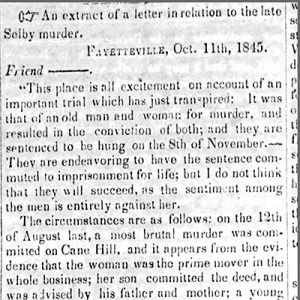calsfoundation@cals.org
Burnett Family (Executions of)
Three members of the Burnett Family were hanged in late 1845 for the brutal murder of Johnathan Selby, “a well to do bachelor about forty years of age,” near Cane Hill (Washington County).
A neighbor found Johnathan Selby’s body on the morning of August 12, 1845, “his head literally chopped to pieces.” As investigators sought Selby’s killer, suspicion fell on Crawford and Lavinia Burnett and their son John, who lived in the area, and whose nephew John Sharp worked in Cane Hill. The elder Burnetts were taken into custody while their son fled the area.
A special session of the circuit court was convened to try Crawford and Lavinia Burnett; future governor Isaac Murphy of Huntsville (Madison County) was among the defense attorneys. During the trial, daughter Mary Jane Burnett testified that her parents had planned the murder, motivated by robbery, and her brother, accompanied by Sharp, had killed Selby. “Weeping, sobbing and with much excitement,” she said that she had washed her brother’s gory clothing. Sharp told jurors that John Burnett forced him to accompany him and that his cousin used a hand-axe to slay the victim.
The Burnetts were convicted and sentenced to hang. Particular blame was attached to Lavinia Burnett, whom one onlooker described as “a stout hearty woman with the appearance of an Amazon” and another as “a hag of the d—st cast, and from all reports, is beyond doubt the instigator of the whole matter.” The trial judge in pronouncing the sentence, said, “Miserable woman! You have not only hurried your fellow being, Selba [sic], into the spirit-world, but you have also ruined your husband, your son, and yourself; and plunged your whole family into the direst calamity and distress.”
The Arkansas Banner reported that as many as 3,000 people amassed in Fayetteville (Washington County) on November 8, 1845, as Crawford and Lavinia Burnett were escorted by 100 guards to an execution site near the present Fayetteville National Cemetery. As the couple mounted the gallows, a witness said that “the old man reached out and took his wife by the hand and indicated that he was ready.” With that, “the sheriff cut the rope, the drop fell, and the two poor, miserable and guilty victims hung between heaven and earth as fit for neither.”
The search continued for John Burnett, with one posse sent on an unsuccessful journey to Texas, where an uncle lived. Moses Cook of Washington County found Burnett in Saline County, Missouri, and arrested him, bringing him back to Fayetteville, where he was indicted for Selby’s murder.
In a two-day trial before a crowded room with most of the same witnesses as in his parents’ prosecution, Burnett was found guilty and sentenced to be hanged on December 26, 1845. A similar crowd gathered in Fayetteville as he ascended the same gallows where his parents had met their fate. On being asked if he had anything to say, Burnett “responded that he was a murdered man; that he was as innocent as a babe unborn.” A witness wrote that “the cap and rope being adjusted, his spirit was launched into eternity.”
For additional information:
“An Extract of a Letter in Relation to the Late Selby Murder.” Arkansas Intelligencer, October 18, 1845, p. 2.
The Goodspeed Biographical and Historical Memoirs of Northwestern Arkansas. Chicago: Goodspeed Publishing Company, 1889.
Neal, Jas. P. “The First Legal Execution in Washington County.” Flashback 6 (January 1956): 32–35.
“An Old Man and Woman to be Hanged.” Vicksburg [Mississippi] Daily Whig, November 11, 1845, p. 2.
Parks-Spencer, Susan. “The John Selby Murder, the Event that Led to the First Legal Hanging of a Woman in Arkansas.” Flashback 73 (Fall 2023): 131–132.
“The Selba [sic] Murder.” Arkansas Banner, November 26, 1845, p. 2.
“The State vs. John Burnett.” Weekly Arkansas Gazette, December 15, 1845, p. 2.
Mark K. Christ
Central Arkansas Library System
 Law
Law Louisiana Purchase through Early Statehood, 1803 through 1860
Louisiana Purchase through Early Statehood, 1803 through 1860 Burnett Family Execution Story
Burnett Family Execution Story  Burnett Trial Story
Burnett Trial Story  Selby Murders Letter
Selby Murders Letter 



Comments
No comments on this entry yet.